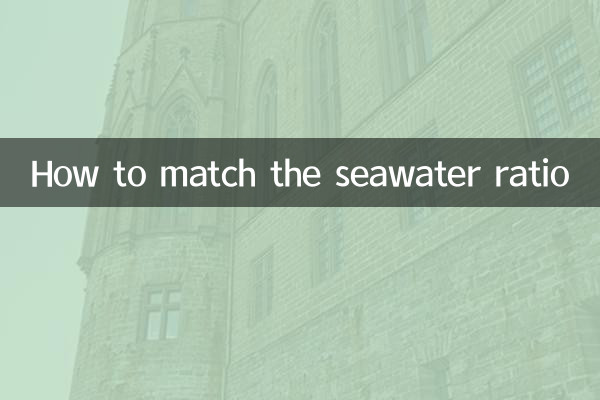How to match the seawater ratio
In aquaculture, laboratory or home aquarium, the preparation of artificial seawater with a ratio of similar to natural seawater is a need for many people. This article will combine popular topics and hot contents on the entire network for the past 10 days to introduce you in detail the method of formulating seawater proportions and provide structured data for reference.
1. The main components of natural sea water

Natural seawater has complex ingredients, but its main ingredients include the following substances:
| Element | Concentration (g/L) | Percentage (%) |
|---|---|---|
| Sodium chloride (NaCl) | 23.5 | 77.7 |
| Magnesium chloride (MgCl₂) | 4.8 | 15.9 |
| Magnesium sulfate (MgSO₄) | 3.6 | 11.9 |
| Calcium chloride (CaCl₂) | 1.1 | 3.6 |
| Sodium bicarbonate (NaHCO₃) | 0.2 | 0.7 |
| Other trace elements | 0.1 | 0.3 |
2. Methods for artificial seawater preparation
1.Basic formula: Taking 1 liter of water as an example, the proportion of seawater preparation is as follows:
| Element | Dosage (g) |
|---|---|
| Sodium chloride (NaCl) | 26.5 |
| Magnesium chloride (MgCl₂) | 5.4 |
| Magnesium sulfate (MgSO₄) | 4.0 |
| Calcium chloride (CaCl₂) | 1.2 |
| Sodium bicarbonate (NaHCO₃) | 0.2 |
2.Simplified formula: For home aquariums or beginners, a simplified recipe can be used:
| Element | Dosage (g/L) |
|---|---|
| Sea salt (commercially available artificial sea salt) | 35-40 |
3.Things to note: When preparing seawater, purified water or distilled water should be used to avoid the impact of chlorine and other impurities in tap water. After dissolution, salinity needs to be measured, usually the salinity range is 30-35ppt (specific gravity 1.022-1.026).
3. Answers to popular questions
1.Can the seawater ratio be adjusted?
Yes, the seawater ratio can be adjusted according to different uses. For example, lower salinity may be required when breeding certain marine organisms, while coral tanks need to be closer to the proportion of natural seawater.
2.How to measure seawater salinity?
It can be measured using a salinity meter, refractometer or hydrometer. Here are the common salinity ranges:
| use | Salinity (ppt) | proportion |
|---|---|---|
| Coral tank | 34-35 | 1.025-1.026 |
| Seawater fish tank | 30-35 | 1.022-1.026 |
| Breeding pond | 25-30 | 1.018-1.022 |
3.Do seawater need to be left to stand after preparation?
Yes, it is recommended to let the prepared sea water stand for 24 hours before using it after it is fully dissolved and stabilized. If used in sensitive organisms (such as corals), pH, KH and other parameters need to be detected.
4. Common misunderstandings in seawater preparation
1.Use table salt instead of sea salt: The lack of key elements such as magnesium and calcium in table salt, which cannot meet the needs of marine organisms.
2.Ignore the temperature effect: Pay attention to the water temperature when measuring salinity, as temperature changes will affect the reading of the hydrometer.
3.Frequently adjust salinity: Severe fluctuations in salinity will cause stress on organisms and should be adjusted slowly.
5. Summary
To prepare the seawater ratio, you need to choose the formula according to the specific purpose, and the salinity and ingredients are strictly controlled. Using commercially available artificial sea salt is the easiest method, but attention should be paid to measurement and adjustment. I hope this article can help you easily master the skills of seawater preparation!

check the details

check the details